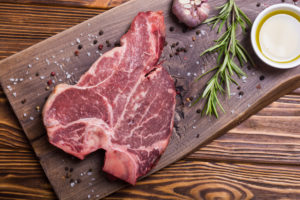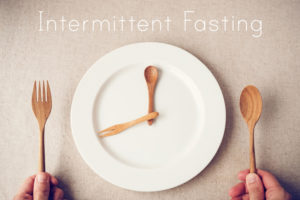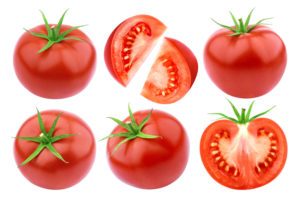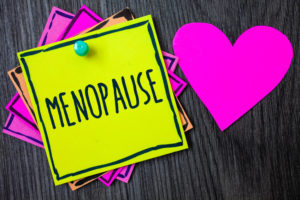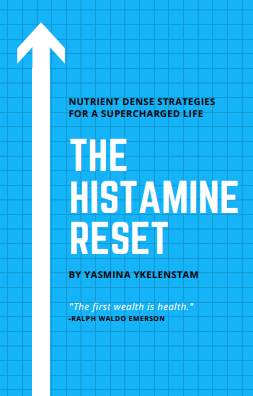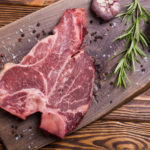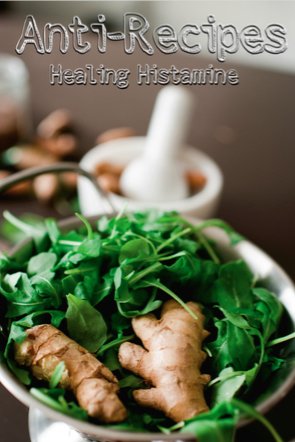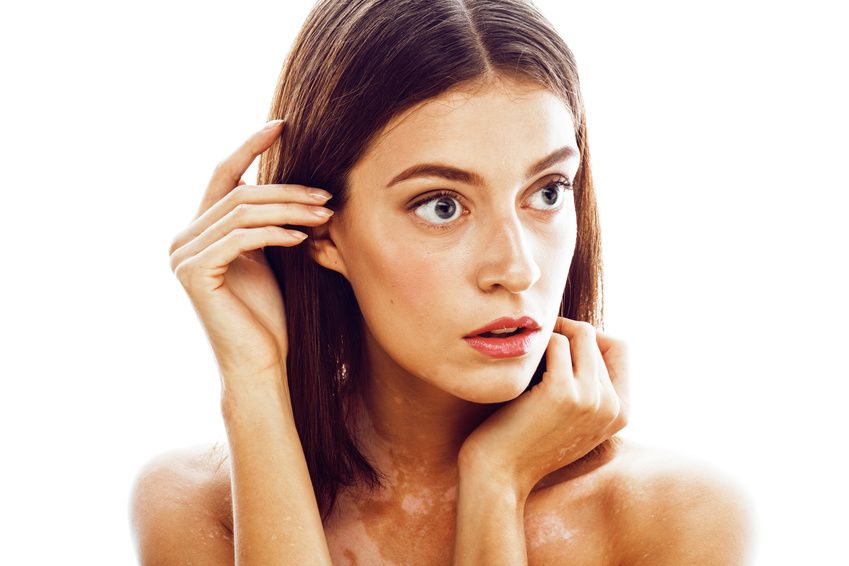
Histamine affects skin pigmentation in a numbers of ways: my two old buddy’s melasma and vitiligo. You know those patches of dark skin on your face that are barely covered by make up, get worse when exposed to the sun, and are aggravated by pregnancy hormones? Yeah, we have histamine and mast cells to thank for those. On the flip side we have the autoimmune skin condition vitiligo, which causes white patches to develop all over. I don’t know about you, but my skin hyper-pigmentation has been a constant source of frustration, so I decided to take a closer look into both.
MELASMA
Sadly I couldn’t find any rights-free photos of this, and I’m far too vain to share any make up free shots of myself, so I’ll just explain. Melasma looks kind of like you didn’t scrub your face right and dirt or bronzing powder got left behind.
Fun right?
A number of studies tell us that histamine is a major melasma trigger. It seems that the release of histamine by skin mast cells, as triggered by ultraviolet light, causes these brown patches on the skin.
What about the hormone link? Yes, pregnancy hormones and birth control are involved, and I’ll be covering them in upcoming posts on the subject. Make sure to sign up to my mailing list so you don’t miss them. But other than the histamine-hormone interplay, other studies have found that histamine and prostaglandins (both released by mast cells) are the primary drivers of sunburn, which is why topical antihistamine cream has become a home care mainstay.
I’ve personally always used a piece of fresh aloe vera plant. You pretty much can’t walk more than a few steps without seeing it where I grew up in Spain, so I’d just break off a piece to nurse my poor skin on the way home from the beach. In my defence we knew little about skin cancer back in those days…
An animal study in the BMC Dermatology Journal found that silymarin cream (milk thistle) effectively treated melasma. The study authors believe that the milk thistle is reversing sunlight damage generally, not just the melasma pigmentation.
Their before and after milk thistle treatment photos were so amazing that they’ve had me frantically rubbing Herb Pharm’s pure extract into my face nightly. I’m impressed so far…
VITILIGO
The Mayo Clinic website tells us that vitiligo is triggered when cells stop producing melanin, the stuff that pigments our skin, hair, and eyes. So far we know that an immune system response, exposure to stress or chemicals, and sunburn can cause it. Complications are sunburn and skin cancer, eye inflammation, hearing loss, and of course, stress.
People with vitiligo are advised to wear sun protection of at least 30SPF and to get their hearing professionally tested. Possible treatments include topical steroid creams that may help re-pigment the skin, topical vitamin D, calcineurin inhibitors (which may trigger lymphoma and skin cancer), ultraviolet light therapy (also skin cancer risk), de-pigmentation of the rest of the skin and skin grafting.
Read my post on vitamin D and histamine here.
The histamine/mast cell link
A 2013 study found that blood histamine level appears to play a significant role in a particular type of vitiligo that’s linked to de-pigmented patches with itching.
My own vitiligo finally cleared up a few years ago. It was never very visible, just a de-pigmentation around my hands that was slowly creeping upwards. I have dealt more with melasma, and still do!
Interestingly, for other types of vitiligo, histamine may be a treatment. A 2010 study found that histamine release in the body triggered by bee venom may be able to add pigment back to the skin.
A few other options worth looking into
Melanin, the skin pigment stuff, is created by melatonin. I wrote about melatonin recently and how supplementing it may help prevent mast cells from leaking histamine. Read the post here.
A study with a small sample size found that patients with non-segmental vitiligo, which is what it’s called when the patches are symmetrical, melatonin was lower than the average. They point out that melatonin is one of the links in the body’s stress defence mechanism and that it also helps modulate immune system function. They concluded that further research was needed.
The Mayo Clinic website also shares that some studies show that Gingko biloba may help return colour in people with slow spreading vitiligo and other studies that folic acid and vitamin B12 may help.
It’s finally here! Man Food – a high nutrient antihistamine and anti-inflammatory ingredient filled book geared towards guys, women who love to work out, yoga like they mean it, or just load up on healing nutrients. Features my personal shopping list of antihistamine and anti-inflammatory foods.
The Anti-cookbook and all liquid Anti-Detox Book, don’t treat any conditions, but feature a plethora of the high nutrient antihistamine and anti-inflammatory ingredients that have been instrumental in helping me feed myself on a limited diet. The Anti-cookbook features a four page list of antihistamine and anti-inflammatory foods and comes in regular and Paleo.
The Low Oxalate Cookbook features antihistamine and anti-inflammatory rich recipes.
Don’t miss the Low Histamine Beauty Survival Guide for non-toxic beauty tips, the skinny on histamine releasing (mast cell degranulating) beauty ingredients, antihistamine and anti-inflammatory beauty alternatives and the top brands natural brands I’ve found.
Take a peek at my other low histamine and antihistamine cookbooks for more high nutrient recipes
——REFERENCES—–
“Vitiligo Treatments and drugs.” Mayo Clinic. N.p., n.d. Web. 24 Mar. 2017.
“What is segmental & non-segmental vitiligo?” Vitiligo Cover. N.p., 23 Jan. 2017. Web. 24 Mar. 2017
Panja, Salilkumar, Biman Bhattacharya, and Siteshchandra Lahiri. “Role of histamine as a toxic mediator in the pathogenesis of vitiligo.” Indian Journal of Dermatology 58.6 (2013): 421. Web.
Brenner, Michaela, and Vincent J. Hearing. “Modifying skin pigmentation – approaches through intrinsic biochemistry and exogenous agents.” Drug Discovery Today: Disease Mechanisms 5.2 (2008): n. pag. Web.
Kwon, Soon-Hyo, Young-Ji Hwang, Soo-Keun Lee, and Kyoung-Chan Park. “Heterogeneous Pathology of Melasma and Its Clinical Implications.” International Journal of Molecular Sciences 17.6 (2016): 824. Web.
Kim, Nan-Hyung, and Ai-Young Lee. “Histamine effect on melanocyte proliferation and vitiliginous keratinocyte survival.” Experimental Dermatology 19.12 (2010): 1073-079. Web.
Gilchrest, Barbara A., Nicholas A. Soter, Jeffrey S. Stoff, and Martin C. Mihm. “The human sunburn reaction: Histologic and biochemical studies.” Journal of the American Academy of Dermatology 5.4 (1981): 411-22. Web.
Hernández-Barrera, R., B. Torres-Alvarez, J. P. Castanedo-Cazares, C. Oros-Ovalle, and B. Moncada. “Solar elastosis and presence of mast cells as key features in the pathogenesis of melasma.” Clinical and Experimental Dermatology 33.3 (2008): 305-08. Web.
Altaei, Tagreed. “The treatment of melasma by silymarin cream.” BMC Dermatology 12.1 (2012): n. pag. Web.


